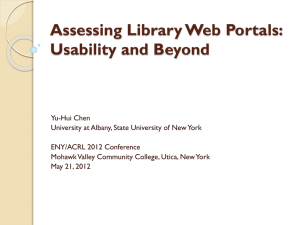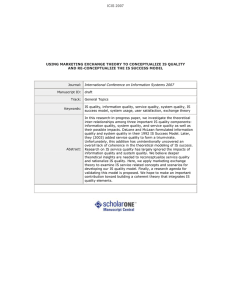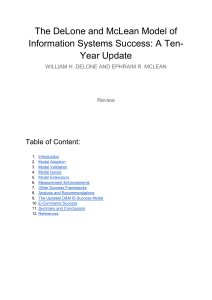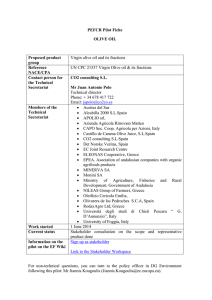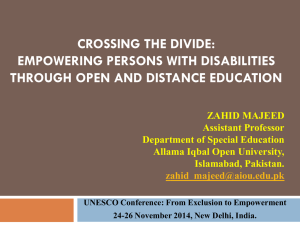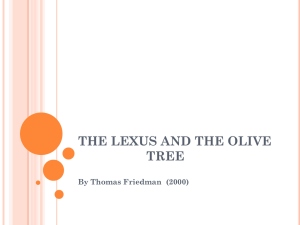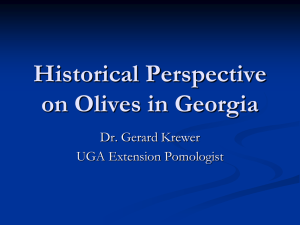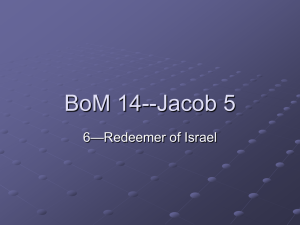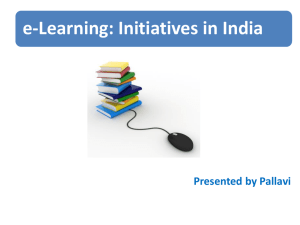DeLone and McLean updated IS Success
advertisement
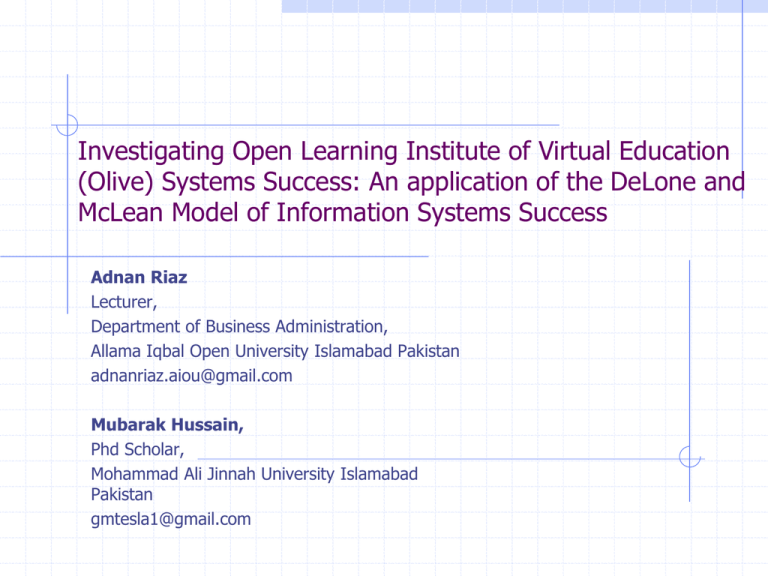
Investigating Open Learning Institute of Virtual Education (Olive) Systems Success: An application of the DeLone and McLean Model of Information Systems Success Adnan Riaz Lecturer, Department of Business Administration, Allama Iqbal Open University Islamabad Pakistan adnanriaz.aiou@gmail.com Mubarak Hussain, Phd Scholar, Mohammad Ali Jinnah University Islamabad Pakistan gmtesla1@gmail.com E-Learning and its significance; Organizations can offer customized training programmes to its diverse employees to bridge the skill deficiencies with reduced time and cost (Wang, Wang and Shee, 2007; Chen, 2010). Modern organizations are rapidly shifting towards e-learning to impart knowledge and skills to its employees (Chen, 2010) as they can deliver training more effectively and efficiently comparing traditional method through technology-delivered training (Welsh et al., 2003). Investing more in e-learning may also results in substantial growth in human capital (Chen, 2010). But still organizations need to determine the success of their systems out of making huge investment (DeLone and McLean, 2004). About Allama Iqbal Open University Allama Iqbal Open University (AIOU) established in 1974, is among the mega universities of the world. AIOU launched MBA/MPA programme for executives in the year 2003 for managers and executives having strong motivations to enhance their knowledge and skills by studying professional courses at advanced level. In 2008, the online version of Commonwealth of Learning MBA/MPA progrmme was offered to masses and termed as Open Learning Institute of Virtual Education (Olive). There is a need to know the success of Olive in delivering education. As organizations of any kind are actively relying on IT based setups, therefore they should be aware of the factors that contribute to IS success (Petter and McLean, 2009). Literature Review e-learning has contemporary satisfaction has of modern time et al., 2002). been the focus of many researchers of and succeeding era. Specifically student acquired the attention of different researchers (Johnston, Killion and Oomen, 2005; Thurmond Moreover, barriers in successful implementation of e-learning and key success factors have been highlighted in many studies. Since organizations spend time and money on establishing IS systems therefore, they strive to know the factors creating hindrance (Welsh et al., 2003; Nichols, 2008). DeLone and McLean IS Success DeLone and McLean initial Model of information success was based on six variables such as information quality, system quality, system use, user satisfaction, individual impact, and organizational impact (DeLone and McLean, 1992). DeLone and McLean updated IS Success DeLone and McLean presented an updated model of IS success (2003) by incorporating the changes and developments in information systems. DeLone and McLean updated IS Success DeLone and McLean Updated Model (2003) has been used in different environments to know the success of different information systems such as; eGovernment system success (Wang and Liao, 2008) e-commerce success DeLone and McLean (2004) e-learning systems success (Wang, Wang and Shee, 2007; Holsapple and Lee-Post, 2006) Purpose of the Research Study: This gave the foundation of this study as; To know the Open Learning Institute of Virtual Education (Olive) Success in Allama Iqbal Open University using D&M IS Success Model. Research Methodology: Subjects and Participants All students studying at various levels (completed at least one semester of this programme) of COL MBA/MPA Programme constituted the population of this study. Procedure (Distribution and Responses) All the students enrolled (N=158) in Olive system of COL MBA/MPA programme were forwarded questionnaire. Total 112 questionnaires (Hard and Softcopy) were received and subsequently analyzed. Research Instrument “System Quality”, “Information Quality” and “Service Quality” (18 items) (Wang, Wang and Shee, 2007). “Intention to Use” and “User Satisfaction” (9 items) (Holsapple and Lee-Post, 2006). “Net Benefits” (10 items) (Holsapple and Lee-Post, 2006) Demographical Characteristics of the Respondents; Descriptive Analysis: Correlation Analysis: Regression Analysis: Conclusion: D&M IS Success Model has been found as most parsimonious model in explaining Olive System success. All the measures “System quality”, “Information quality”, “Service quality”, “Intention to Use”, “User Satisfaction” and “Net Benefits” and their assumed relationship is fully supported by the results. However, “system quality” is appeared as key variable having strong positive impact on both “Intention to Use” and “User Satisfaction”. Furthermore, “Intention to Use” and “User Satisfaction” are found key predictors of explaining “Net Benefits”. Practical Implications: All the measures of D&M IS Success Model such as “System quality”, “Information quality”, “Service quality”, “Intention to Use” and “User Satisfaction” should be given due focus within the context of Olive system. Since “system quality” is found as the most critical component impinging upon “Intention to Use” and “User Satisfaction”. Therefore, attempts should be made in developing components of Olive more customized in nature to meet the specific needs of the students. The university should make it mandatory for students to use different components associated with Olive System such as discussion forums, e-chat sessions, reference websites etc. By doing this, user will be more satisfied and Olive system would be a great success in AIOU. Thank You!

